When race directors Lisa Smith-Batchen and her husband Jay Batchen say that it snowed in
the Tetons two weekends in a row this month, I think they are
talking about August.
That's typical in the Rockies at these elevations, so we were
prepared for anything when we arrived in the area a few days
ago. Although the nights have been down into the 40s at our
campground in Teton Canyon all week, daytime temperatures have
been in the 70s and 80s -- warmer than I expected around
here in early September.
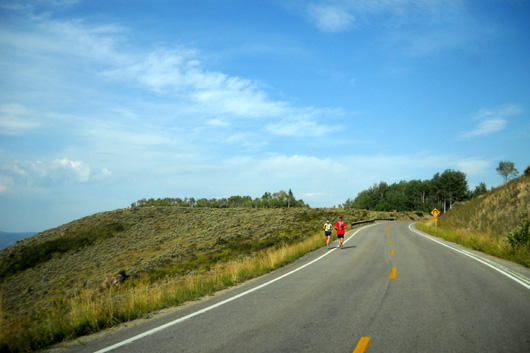
Mid-morning sunshine as ultra runners head up Ski
Hill Road on Saturday
Fortunately, this year's GTR runners missed the snow and wintry weather that
made the inaugural Grand Teton ultras extra memorable in 2005. It was
still definitely summer this time, with
temperatures approaching 90°F. at
the lower elevations on the course, which ranges from 7,000 to
10,000 feet.
We had similar high temperatures
when Jim ran this race two years ago, but this time he was
better heat-trained.
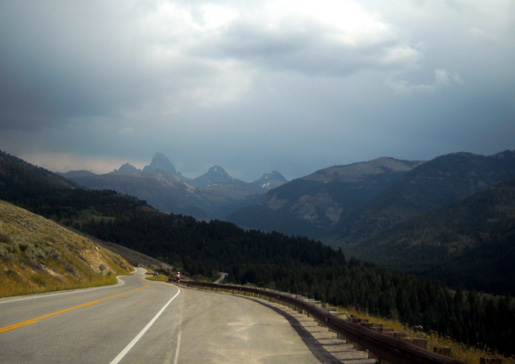
Mid-afternoon clouds looking the other
direction on Ski Hill Road
By afternoon on Saturday the sky
became increasingly overcast and a few raindrops fell, but I
don't believe anyone got thoroughly soaked along the course. If
they did, it probably felt good!
SOME FACTS ABOUT THE RACE
This is the fifth year for the
Grand Teton ultras and the
first year that a 10K was added to the marathon, 50-mile, and
100-mile menu of options for runners. There is also a kids' fun
run.
With five different race distances
(some on Saturday, some on Sunday), the convenient Base Aid
Station where runners are always coming and going throughout the
weekend, and a variety of things to do at the resort, this is a
very family-friendly race.
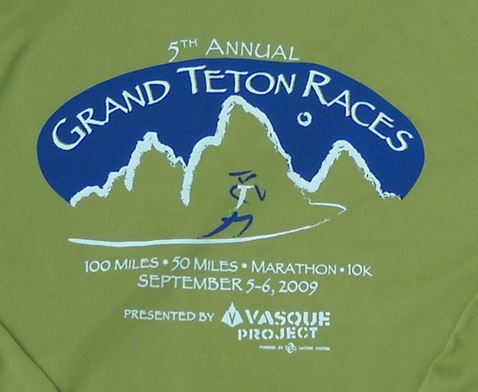
Race logo on the entrants' shirts
All race activities take place at
the Grand Targhee Resort on the western slope of the Grand Teton
Mountains. The address is Alta, WY but the resort property is
about a dozen miles from the little town that sits on the
Wyoming-Idaho border.
This is a great venue for the
event, with a variety of trails that I showed in the last two
entries, food and lodging on site (it's expensive but
convenient), and nearby camping options.
This year the resort allowed
runners to camp free on the property on race weekend. We chose
to remain about seven miles away at our NFS campground site in
Teton Canyon since Jim was doing just the 50-mile race. If he had
entered the 100-miler, we might have moved up to the resort for
the weekend. We saw several RVs in the upper and lower parking
lots, and tents down in a nice treed area, so it looks like some
of the runners opted to stay close to race HQ.
It's nice that
Lisa and Jay were able to finagle this arrangement with Grand Targhee
this year; two years ago the resort was charging
$25/night to camp in their parking lots with no hookups, which
was more expensive than staying down in the canyon with
hookups and closer to a Verizon cell signal. (There is little or
no Verizon service at the resort, although we got a great signal
on top of Fred's Mountain!)
Here's a map of the race
course one
more time:
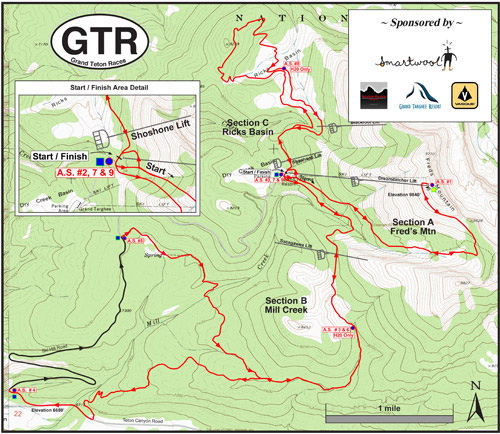
I described the course in some detail on
Friday in two entries where I
showed lots of photos from all around the course. You can also see the
course profile there or on the race
website.
Briefly, all those red and black lines you see above are 25
miles of the course. Each 25-mile "loop" has three segments,
with the beginning and end of each segment at the Base Aid
Station (which is the main cluster of buildings at Grand Targhee
Resort).
Runners in the 50- and 100-mile races do Section A to the summit
of Fred's Mountain first, then Section B on Mill Creek Trail,
Ski Hill Rd., etc., then Section C in Ricks Basin. Fifty-milers
do each section in order twice. Hundred-milers do them four
times. (Marathoners do this course once, plus an additional 1.2
miles to total 26.2. The 10K race is in Ricks Basin.)
Time limits in the ultras are fairly generous. Hundred-milers
have 36 hours in which to complete the race. Although the
50-mile limit was advertised as 18 hours this year, the last two
runners in that race took 21+ and 25+ hours to finish. I like
that approach, since the aid stations are open for the
100-milers anyway.
FRIDAY'S PRE-RACE ACTIVITIES
Packet pick-up for all the races
was held in a nice conference room at the resort at two different
times on Friday. We drove up in mid-afternoon so we had some time to mingle with
friends before and after getting Jim's race number, shirt, and
bag. It was fun to see Hans-Dieter Weisshaar and his wife Susi
from Germany/Mexico, Francesca (Frankie) Stone and her husband
Doug from California, Paul Grimm from
Colorado, and George Velasco, also from California.
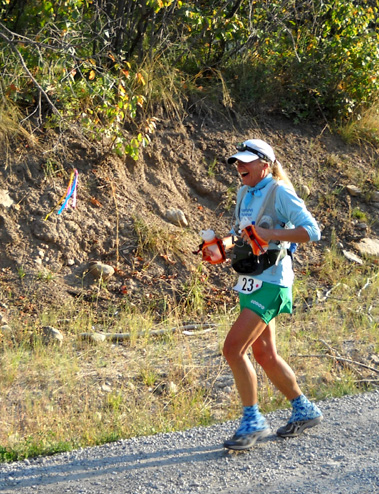
Frankie is all smiles her first time down
to Teton Canyon.
We usually know more runners at
100-milers but those are the only folks besides Lisa and Jay
that we knew this time!
One of the great things about ultras,
however, is making new friends. Now we can add some
others to our list of ultra friends, such as Janice O'Grady from
Colorado (F60 winner in the 50-miler) and the effervescent Benji
Chu from British Columbia, who entertained everyone at each and
every aid station (and probably all along the trail) on Saturday
in the 50-miler. Although his yelps and jumps weren't quite as
big after 12+ hours, his enthusiasm never wavered. He was a
crowd favorite:
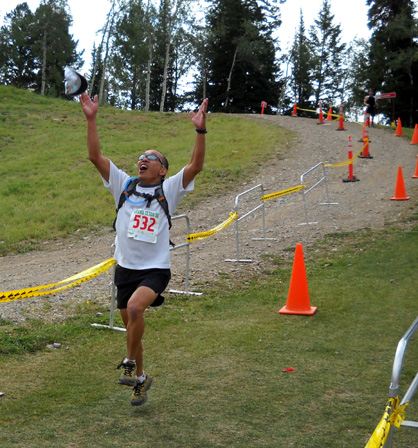
Could you show a little more enthusiasm,
Benji?? What a character!
Here he's coming into the Base Aid Station
at 20 miles.
Packet pick-up was casual but well-organized, just like
everything else about this little gem of a race. Lisa and Jay
are attentive to details yet appear relaxed all weekend, despite
the myriad of activities going on. I don't know when they sleep!
Jim's favorite cool-weather running shirt is the long-sleeved
Smartwool number he received at this race two years ago. We baby
it to keep it looking nice -- cool water in the washer
and air drying. You can see photos of it in one of my
2007 race entries. We were hoping the entrants in the ultras would
get another wool shirt this year. Alas, they didn't, but the
soft synthetic Patagonia shirts they did receive are almost as
nice, and probably more durable:
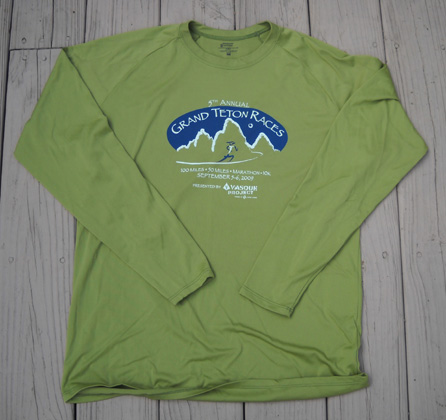
An informal race briefing was held
in a nearby room from 4:30-5:30 PM on Friday. Jay
and Lisa described the course, reminded runners of some of the
race rules, and answered questions before handing the microphone
to Dr.Naomi Sklar, the race medical director, and Sister Mary
Beth Lloyd, the inspiration for Lisa Smith-Batchen's prolific
ultra endurance
fundraising projects for AIDs
orphans.
And not only would the Sister
talk, she'd also run and walk her first 50-miler this
weekend!!
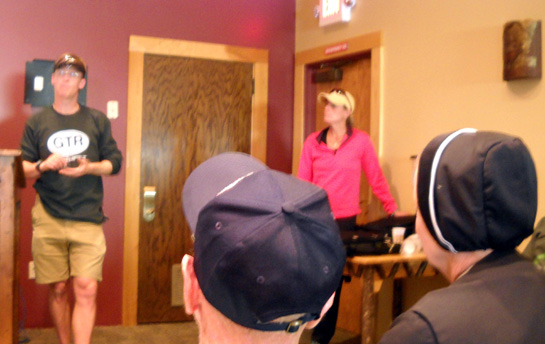
Jay and Lisa Batchen (standing) at the
pre-race briefing; Sister Mary Beth is in the right foreground.
We opted out of the pre-race dinner
at Grand Targhee and ate dinner in our camper. Although it's
nice to socialize with other runners over pasta, we prefer races
like GTR that don't include $15-20 dinners in their race
fees because it helps us reduce costs.
SATURDAY: RACE DAY
It was partly cloudy and 48° F.
when we got up at 5:30 AM for the 7 AM start of the
50-miler. I'm guessing it was colder a thousand feet higher at 6
AM when the twenty-six 100-milers started their race. Jim was
one of 36 who began the 50-miler.
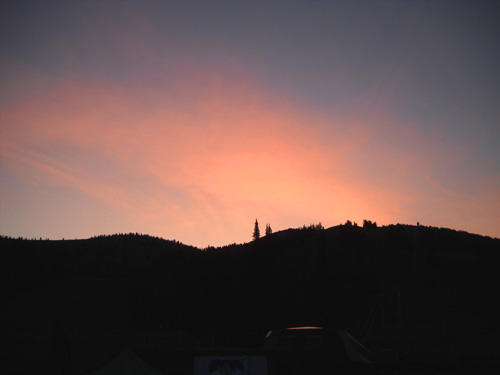
Sunrise over the lower slopes of Fred's
Mountain
Jim doesn't usually eat much this early in the morning. His
standard pre-race breakfast is a banana and a liquid like Boost
(or the Sam's Club equivalent), both of which digest easily. The
race also provides the 50- and 100-milers with some pre-race
coffee, juice, fruit, and bagels in Wild Bill's restaurant at
the resort.
We were still down in our camper in Teton Canyon when the
100-milers started at 6 AM. Many of the 50-milers were already
on-site when we got up to the start/finish area for check-in
before Jim's race. Here are some views of the Base Aid Station
before the 50-milers headed a hundred yards uphill to the start
line:
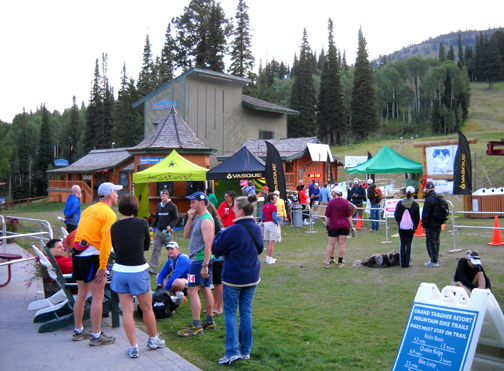
Above and below: both sides of the Base Aid
Station, the center of the "cloverleaf" course
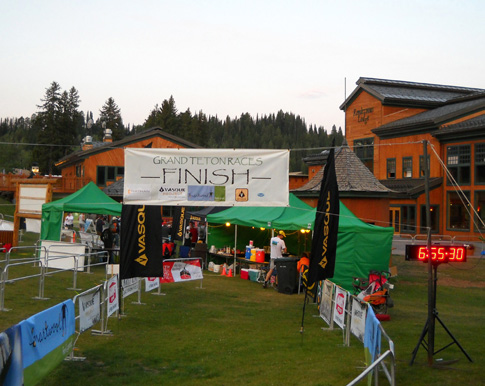
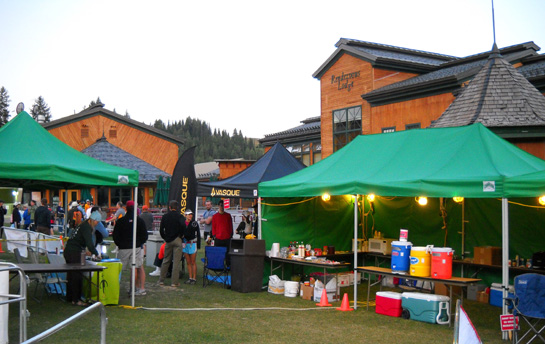
The 50-milers started heading up the
short hill from the Base Aid Station to the start a few minutes
before 7 AM. Everyone looked pretty relaxed as they talked and
waited for Jay to tell them to head on up to the summit of
Fred's Mountain, a climb of about 2,000 feet in just under three
miles.
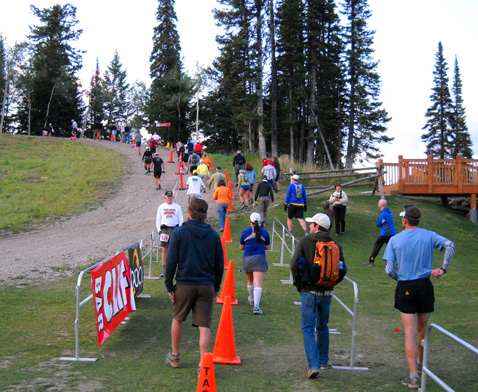
Above and below: I'm coming, I'm
coming! Jim, in white shirt, turns to look back at me in both
photos.
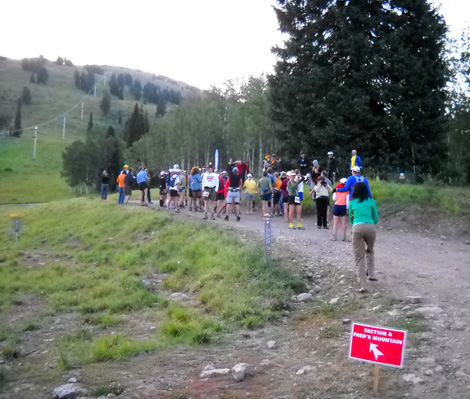
I'm guessing there was more anticipation than fear their first
time up the mountain. By the second time, there may have been
more dread!
As we waited for 7 AM, 100-mile leader Ty Draney came into
sight. Everyone cheered as he sped down to the Base Aid Station.
You can see some of the waiting 50-milers pointing toward the
right, tracking Ty:
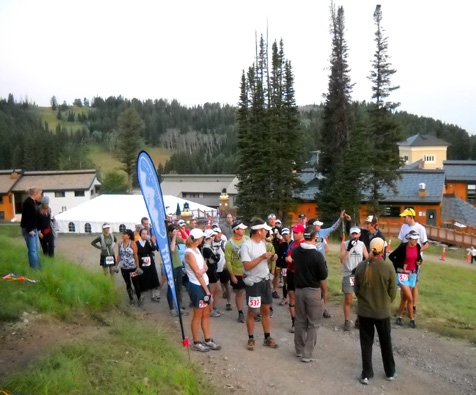
Ty completed that 5.6-mile trek to Fred's summit and back
in exactly one hour. (Here is a
link for 100-mile runners'
splits.) Although he didn't do the next three trips
up and back that fast, he still held on to win the 100-miler.
I
got several photos of him during the race. This one was right
after the 50-milers started their race, as Ty (#11) began his first
segment on the Mill Creek Trail:
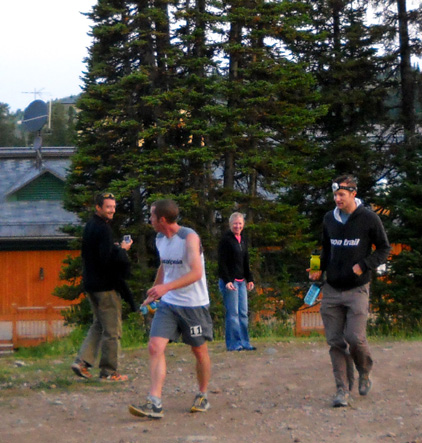
Before he got to that spot, however, Jay sent the 50-milers on
their way:
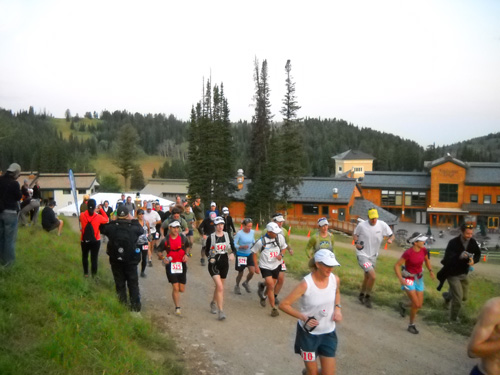
Jim (below) looked happy to be off and running, although
everyone would soon be walking up that mountain! Sister Mary
Beth Lloyd is just behind him in this picture:
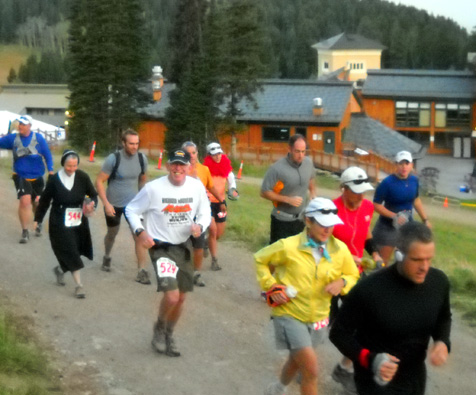
KEEPING IT SIMPLE
After Jim began running, I wandered over to Fred's Basin for 4+
miles of running and walking before any of the runners reached
that loop. It was marked by then, of course, and I could see
exactly where we missed the short-cut turn on our training run
several days earlier.
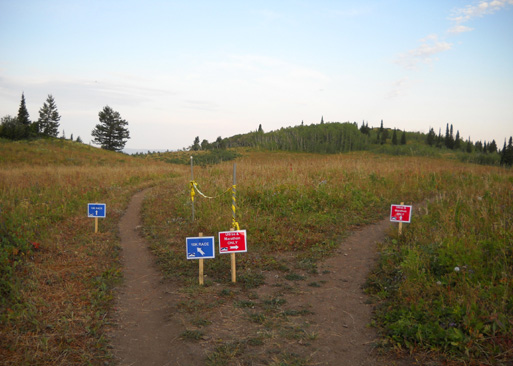
I could also see an station canopy set up
across the basin; it was right where Jim remembered. You
can barely see the bright green tent iin the distance in this
picture:
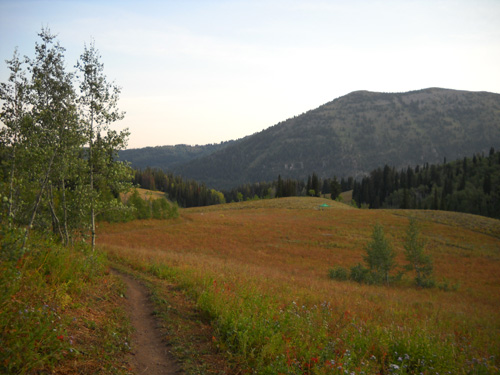
I really enjoyed that run and wished I could have stayed out
longer but 1) I wanted to be out of the basin before the 10K
race began at 8:45 and 2) I needed to get back to Base before Jim came down
from Fred's.
This is the view of the aid station as runners
approach it from Ricks Basin:
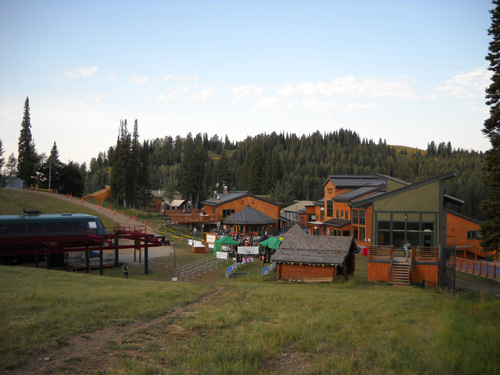
I was back and ready for Jim just in the nick of
time. It took him only 1:13 hours to make the round-trip
on the first section, ten minutes faster than his best-case
scenario prediction. (You can see the aid station splits for
Jim and other 50-mile runners at this
link.)
Here he leaves
Base at 8:13 AM and heads for Section 2, the Mill Creek
Trail:
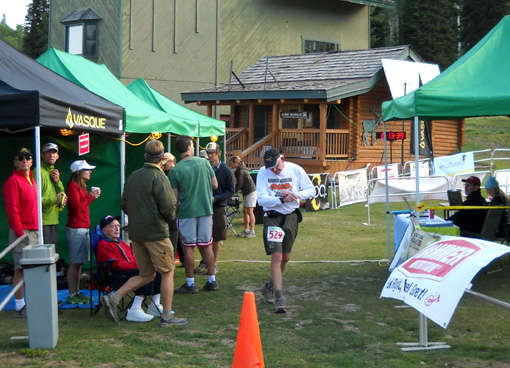
My crewing MO (modus operandi) was similar
to two years ago. This time I knew Jim wouldn't be out
there all night in the 100-miler. That made both of us more
relaxed and casual about the whole thing. He didn't need near as
many clothes or supplies so he wasn't as dependent on me to crew
for him.
Jim chose to drink and eat
primarily what was available at the aid stations, supplemented
with flasks of espresso-flavored Hammergel and cold bottles of Perpetuem that I had available each time I
saw him. I was able to get ice at the aid stations before he
came in each time.
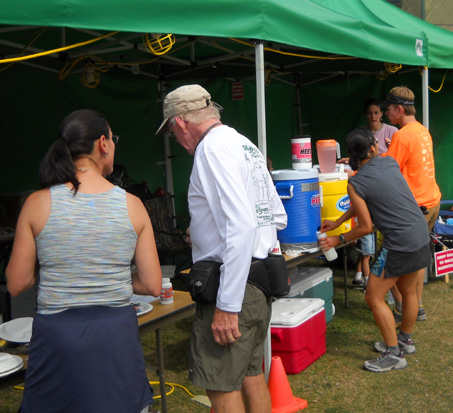
A volunteer helps Jim with food selection
at the Base Aid Station.
Jim was fine
all day and into the evening with his white long-sleeved
synthetic Big Horn shirt and Promise Land running shorts:
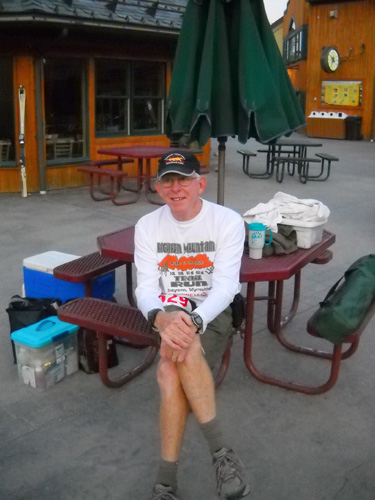
Jim relaxes before
the race begins. That's his one drop box on top of the table.
We had extra socks, two other pairs of shoes,
another running shirt, a Marmot jacket, his Solumbra sun shirt,
gloves, an extra hat, a couple of flashlights,
spare batteries, lubrication, sunscreen, and other supplies
either in the truck or in his drop box in case he needed any of
those items during the race. He did not need to change his
Injinji toe socks or
Asics 2130 road shoes or even use his sun shirt -- the
day got progressively more overcast and he never needed it.
CREWING DOESN'T GET MUCH EASIER
This is one of the easiest races to
crew of any that Jim and I have ever attended. Although it's not
as easy as a fixed-time race on a short loop course (think
Hinson Lake or ATY), runners come through the Base Aid Station
at the start/finish every five to fifteen miles -- six
times in the 50-miler, twelve times in the 100-miler.
Crews are allowed to drive to only
two other aid stations, both along paved Ski Hill Road (runners
have other manned and un-manned aid stations). They are easy to
find and there is ample parking at each one, since there aren't
a lot of runners in the race and they get spread out quickly.
Some folks like Susi set up a chair
and boxes with their runner's supplies only at the Base Aid
Station. Crewing doesn't get much easier than that! Although she
and Hans drive a small RV, it's easier to leave it nearby in the
parking lot than to drive it to aid stations. The stations on
Ski Hill Road are well enough staffed and supplied that runners
can get by pretty easily at GTR without crews (they can have
drop bags there if they want them).

Susi relaxes and waits for Hans to come
into the aid station on Saturday morning.
I set up our chair on this side of her. No
one bothered our supplies when we left to do other things.
Susi is better able to occupy
herself for hours at a time in her camper after Hans goes out on
another segment than I am in our truck . . . so at this
race I prefer to set up a chair at Base and move Jim's crew
box(es) between there and the other two aid stations throughout
the race. It gives me more to do. Jim doesn't usually need
me there, but it makes my day more interesting to see him and
the other runners more frequently. I'm too fidgety to just sit
and read, and no one needed my help at any of the aid stations
during the day.
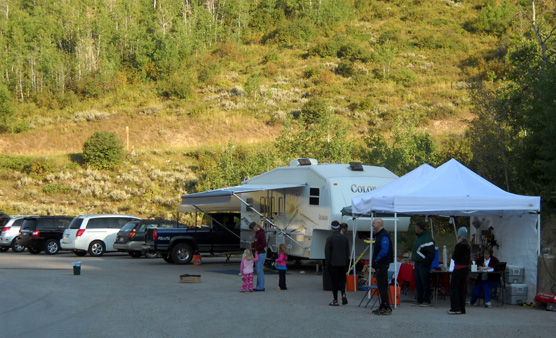
Above: Lower Ski Hill AS on race
morning; runners pass through here and go up Ski Hill Road,
below:
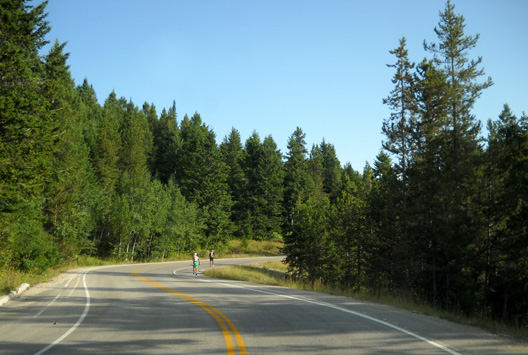
I saw Jim all six times he came
through Base (including the finish), twice at Lower Ski Hill,
and once at Cold Springs. I missed him the second time he came
through Cold Springs at 36+ miles because I drove down to Driggs
to get e-mail, make some phone calls, and buy milk (we'd been
warned that most stores in Driggs are closed on Sunday).
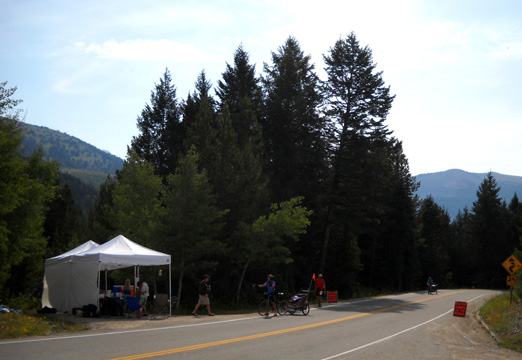
Runners come up the road to the Cold
Springs AS and turn onto a dirt jeep road next.
Even though I was coming and going
all day I ended up spending a lot of time
talking to Susi at the Base Aid Station anyway. I enjoyed that. Hans often came
through a little before Jim, so Susi and I were usually there
about the same time.
The Base AS is a great place to
people-watch:
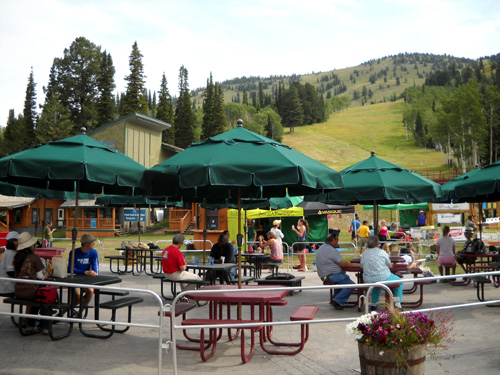
Spectators can sit under canopies, eat
lunch, and watch the runners from a distance or get up closer.
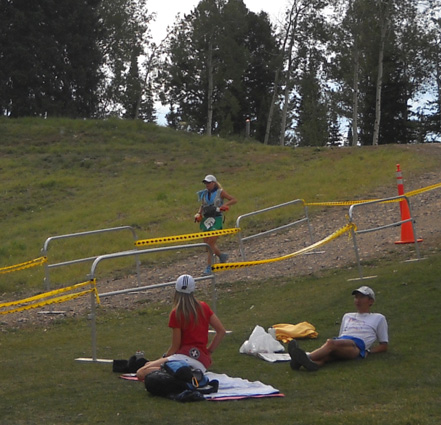
Paul Grimm (white shirt) and another crew
member relax on the turf
as Frankie Stone comes into Base from the
Mill Creek Trail section.
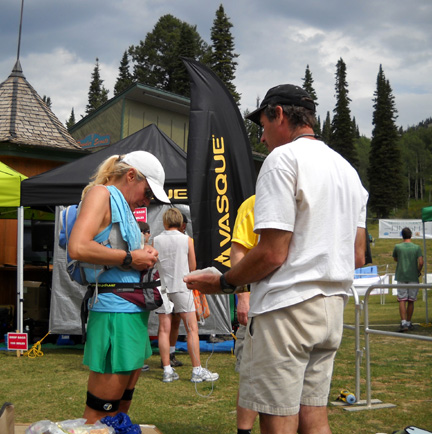
Frankie is assisted by her husband Doug at
Base
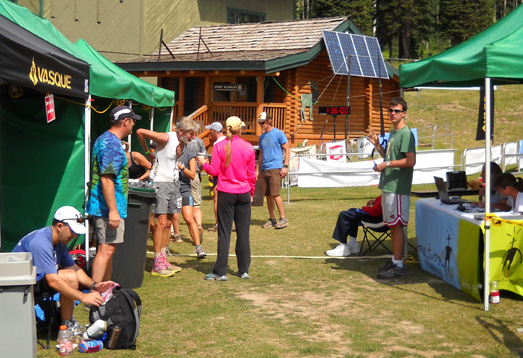
RD Lisa, in bright pink top, helps Hans-Dieter
(white singlet) at Base
Two years ago Susi and I decided to surprise our fellas by
taking the chairlift up to the summit of Fred's Mountain the
second time they ran that section. It was great fun for us. We
took advantage of the Lunch & Ride ticket, which was a good deal
then at $15.
This time neither of us went up there on the lift. I'd already
hiked up and run down earlier in the week and didn't want to pay
the increased price for the ticket this year. It just wasn't as
appealing an idea as it was the first time, I guess. Been there,
done that. In addition, now I'd have to deal with all the
cyclists on the chairlift . . .
YIKES! BIKES!
The Base Aid Station got even busier in the afternoon
when lots of downhill mountain bikers showed up. It was the same
on Sunday.
I talked
about the popularity of the new bike trails on Fred's Mountain
in an
earlier entry. The cyclists had
to cross the race course near my crewing spot (below) to get to
the Dreamcatcher chairlift that took them and their bikes up to the summit and the
beginning of their downhill trails. I was surprised so many of
them would come out during the foot
races, but the weather was good and their season will be over
soon. This is very different from two years ago.
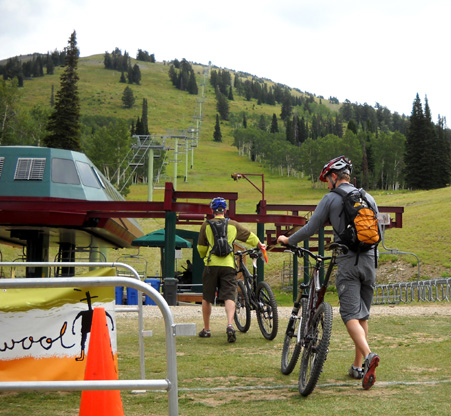
These guys aren't wearing the leg and arm
pads that many of the other downhill cyclists had on.
Jim said he had to be careful going
up and down the mountain the second time. The bike trails
cross the race course several times and the cyclists didn't
always yield to the runners on the road as they were supposed to.
He saw only one cyclist on the Mill Creek Trail during the race
(no problem with that one) and none in Ricks Basin.
[Speaking of Ricks Basin . . . if
you look at the results, you'll see several folks in the
50-miler, marathon, and 10K with the last name of Ricks.]
MORE ABOUT JIM'S RACE
Jim looked great at all the aid stations. Unlike two years ago at
this race, he had no problems with eating enough calories and
drinking enough fluids.
He didn't get nauseous, dehydrated, or hyponatremic this time. He
was glad the sky was overcast most of the afternoon to mitigate the
high temperatures.
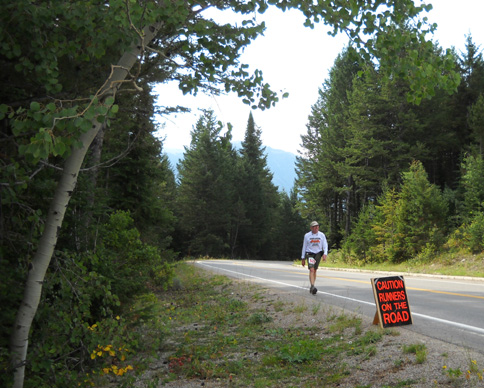
Jim approaches the Cold Springs AS at 14+
miles . . .
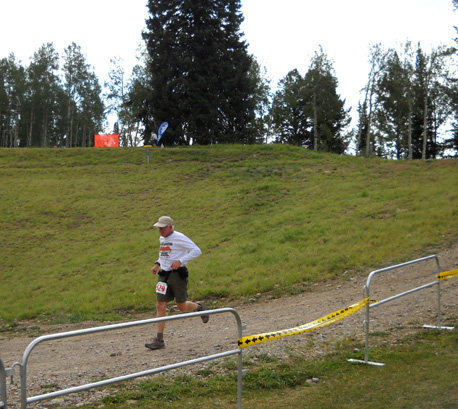
. . . the Base AS at 20 miles . . .
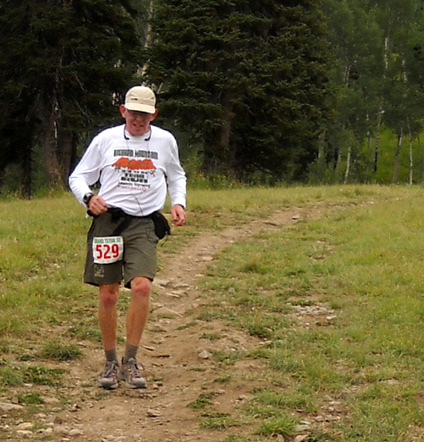
. . . and back to Base at 25 miles --
halfway done and still running strong!
Although he slowed down gradually as the day progressed, Jim's
energy level and motivation remained good. It really helped him
mentally to know he was going "only" 50 miles and not 100. He
had more fun talking with other runners and enjoyed the scenery
more this time, all while staying ahead of his projected splits.
That's the way to run a race!
After almost missing him at the first aid station stop because
he got down from the summit of Fred's ten minutes "early," I
made sure to get to each aid station well before I thought he'd
arrive.
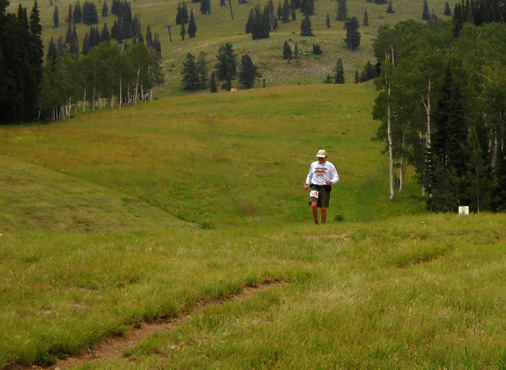
Still smiling after his second trip down
from the summit of Fred's Mtn. at 31 miles
Lisa and Jay are pretty accommodating about runners being paced in
the ultras, especially those over age 60. Jim was doing so
well at the end that I didn't feel the need to accompany him on
his last five miles in Ricks Basin, but I did walk up the hill
with him as he began that loop about 7 PM and out about a third
of a mile. Since it might get dark while he was out there, he
took his flashlight on that loop.
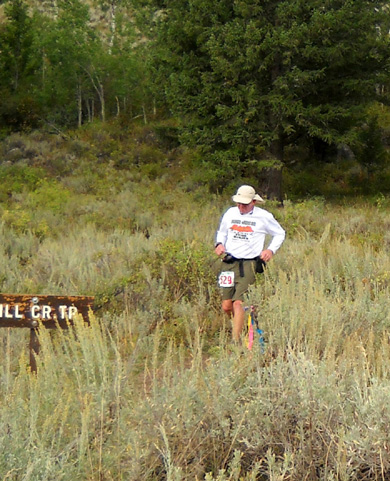
Jim runs down the Mill Creek Trail to its
trailhead at Teton Canyon Road . . .

. . . and follows it to the Lower Ski Hill
AS at 36 miles. Note the distinctive Grand Teton Range.
In retrospect, I wish I'd run/walked that section with him
because I love the basin trails so much. Instead, I went back to
move the truck closer to the finish area and took more warm
clothes over to our chair just outside the aid station tents. He
was back by 8:17 PM.
Jim's finish time was 13:17:40 hours, which placed
him first in the M60 age group and 20th overall out of 33
finishers and 39 starters in the 50-mile race. It was fairly
dark when he finished and I missed seeing him coming down the
hill soon enough to get a decent photo of him crossing the finish line.
This is the best I could do:
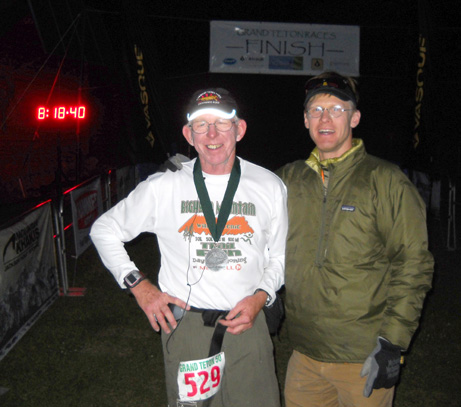
Jim with his finishers' medal presented by
RD Jay Batchen at the finish line
See the time in that photo? Jim wishes it was his race time, but
alas, it's the time of day!
The three-inch diameter bronze 50-mile finishers' medals are
very handsome:
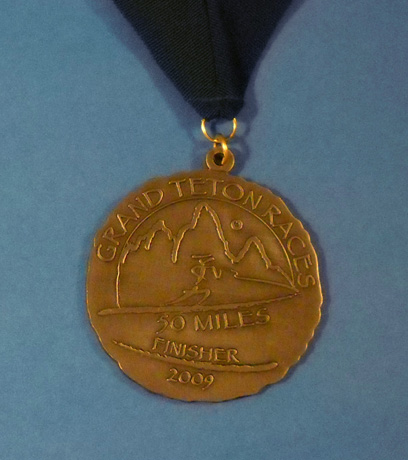
Dr. Naomi was working in the Base Aid Station when Jim finished.
She quickly bundled him in a warm blanket while I got him some
hot soup to eat. As soon as the sun sets in the mountains, the
temperatures drop precipitously. Jim gets cold very fast after a
race even on a hot day. He put on pants and a jacket when he was
ready to walk to our pre-warmed truck.
Once back at the camper, he discovered a blister just below his
ankle bone on the outside of one foot. Luckily, it didn't start
to bother him until four miles from the end. He just toughed it
out, knowing he didn't have far to go. It should heal quickly
and not bother him when he's ready to resume training.
SUNDAY: AWARDS & RESULTS
We slept late on Sunday morning and missed the start of the
marathon at 7 AM and the kids' fun run at 9. We drove up to the
start/finish area about 10 to see how folks were doing. We saw
quite a few of the marathoners walking up the dirt road in the
canyon and on Ski Hill Road, as well as a few 100-milers. The
100-milers still had plenty of time left; their final
cut-off is 6 PM on Sunday, and a few would take most of that
time to complete their journey.
For reasons I'll explain later, we decided to leave the Teton
area
about lunchtime and not stay for the post-race BBQ from 12:30-4:30
PM or the awards ceremony at 4 PM. When we explained our
predicament to Jay and Lisa, they verified that Jim did win his
age group and let us get his very nice M60 award so we could leave. We appreciate that. This is the
attractive ceramic
plaque he won, hand-painted by a local artist:
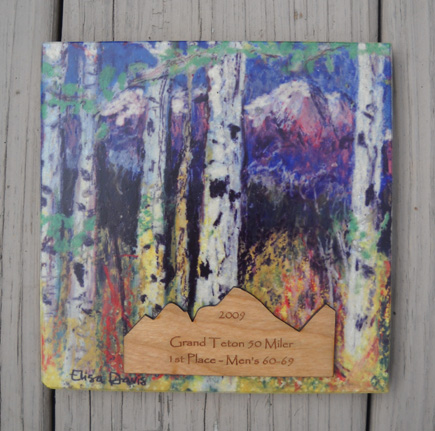
Overall winners in the ultras received a framed, larger plaque.
Very classy!
You can see results for all four races at this
link. GTR has provided prompt and accurate
live results during the race for several years, one of many
special features of this event.
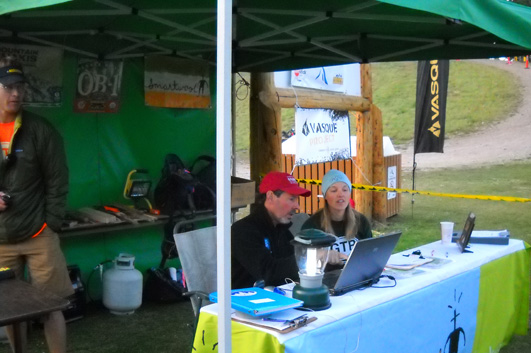
Timers input data as the 100-milers begin
coming into the Base Aid Station.
Here's a quick summary of the three longest races:
- 100-miler: 69% finish rate (18 of 26 who started).
First male = Ty Draney in 19:19:51. First female and 2nd
overall = Ashley Nordell in 23:03:39, which I believe is
one of three new course records this year. Last finisher, George
Velasco, finished in 35:33. Our friend Frankie were
unable to finish this time but I bet she'll be back!
- 50-miler: 92% finish rate (33 of 36). First male =
Duncan Callahan in a new course record of 7:33:27, not
bad after finishing 3rd recently at the Leadville 100! First female
and 7th overall = Becky Kirschenmann in 10:34:06, also a
new course record. Jim was 20th in 13:17:40. Last place finisher
Andrea Pritchett was on the course for 25:27 hours.
- Marathon: 87% finish rate (40 of 46), with a time
range of 4:26 to 8:20 hours.
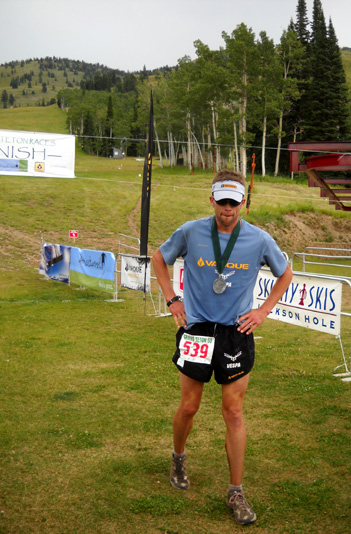
Duncan Callahan right after his
course-record finish in the 50-miler
SOME RANDOM OBSERVATIONS
I am surprised the race hasn't grown larger in five years,
considering all the special features, generous time limits, and gorgeous
scenery. This race is a gem. Actually, I'm glad it's not big because
each runner, crew person, and volunteer is treated with considerable
care and respect. Lisa and Jay are two of the most appreciative and best-organized
race directors we know.
Because of that, most of the volunteers are loyal and dedicated
veterans by now. A new family was in charge of the Cold Springs AS this
year, however. I think they did a superb job and hope they will be back
again. Three generations ran that
aid station as if they'd been doing it forever:
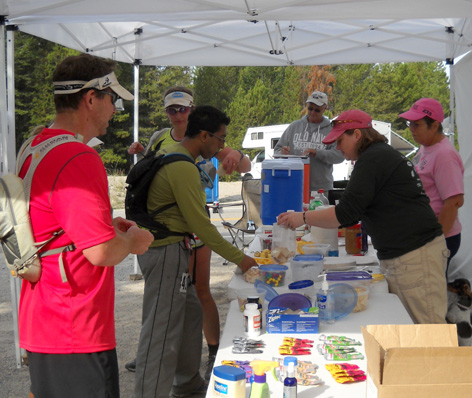
I really enjoyed talking
to them while I was waiting for Jim the first time he came through the
AS and when I returned from a run I did on that part of the course (I'd
missed it on my earlier training runs). Cody had fun meeting their young
yellow Lab (Marley, of course) and mini dachshund, Rosie.
This 100-miler will eat you up and spit you out if you aren't
physically and mentally prepared for it. Even with a fairly generous
time limit, the high altitude, significant elevation gain and loss,
variable weather, and repeated loops can wear on even the best-trained
runners who have finished other mountainous 100-milers. It takes a lot of
determination to keep going "out there" time after timje after time
(twelve times in all!) from the comfort of the
Base Aid Station. The course demands more respect than you'd think.
Every runner has a story; I'll comment on just three of the most
determined of them that I know about here.
Hans-Dieter Weisshaar, age 69, finished 12th overall in the race,
looking almost as fresh when I last saw him Sunday morning as he did
when I repeatedly saw him on Saturday.
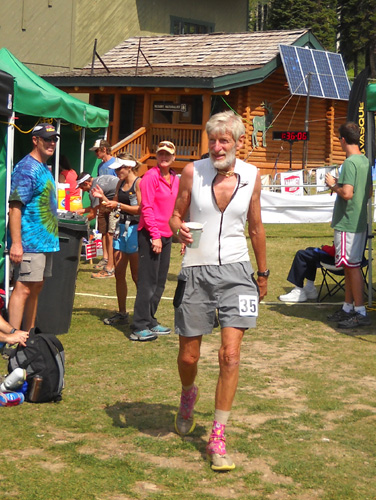
Known for finishing over a
hundred 100-milers in his 60s (I've lost count), GTR is one of six 100s
Hans plans to run in the next six weeks. He spent most of the summer
running long distances in Europe to prepare for this feat.
Hans and Susi are one of my favorite couples. Susi says Hans may "hang it up" when
he turns 70 but she and I both hope he continues running ultra races for
a long while yet (our reasons are different -- she has to live
with all that energy, and I just want to keep seeing them!).
George Velasco has run this 100-miler four times; this is his
third finish at the back of the pack. He is tenacious!
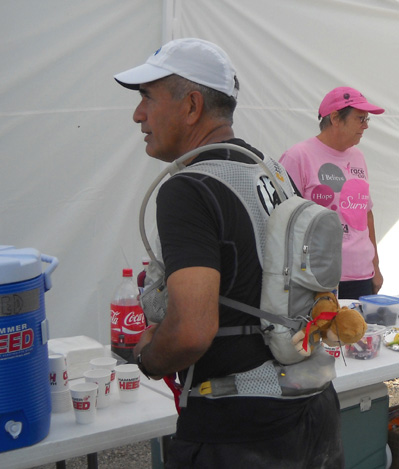
I noticed the
stuffed toy strapped to his water pack during the race and asked him
about it. He said it represents the "monkey on his back" from last
year's DNF. All the comments he received during the race helped motivate
him to keep going. George also comes early to the Tetons to help Jay
mark the course each years. Thank you, George!
Sister Mary Beth Lloyd was an inspiration to many of us who were
either running the race or observing it.
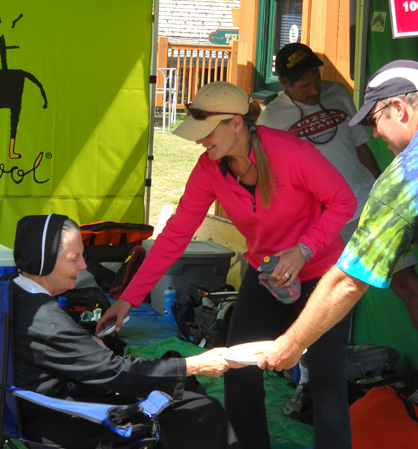
Sister Mary Beth receives aid at Base from
RD Lisa Smith-Batchen and a volunteer
while Doug Stone tries to get out of my
picture in the background! (Hi, Doug!)
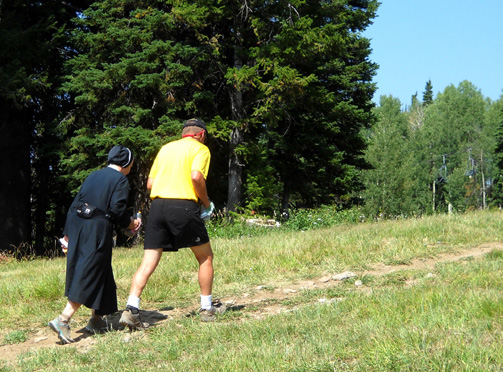
Sister Mary Beth and her pacer head out to Ricks Basin
at 20 miles.
In her 60s, and wearing
her long habit the entire race, Sister Mary Beth doggedly walked her first
50-miler on one of the more challenging courses this
country has to offer. She was the next-to-last finisher in that
race in 21:21. Not bad, especially when you consider that
she lives in New Jersey and can't acclimate up to 10,000 feet
anywhere close to her home!
I'm very proud of Jim, too. He managed everything very
well in this race and finished faster than he thought he would.
Even better, he had FUN this time! Good job, Sweetie.
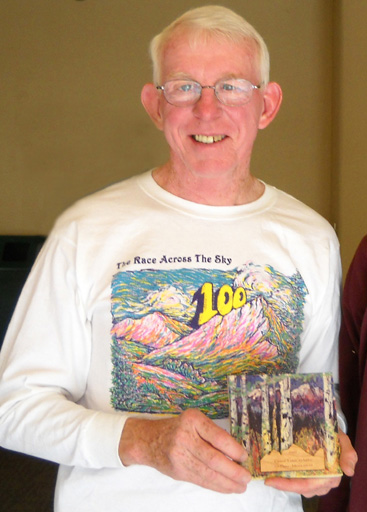
Check out our
Picasa site for additional race
and course photos (and larger versions of the ones on this
website).
Next entry: another chapter begins
Happy trails,
Sue
"Runtrails & Company" - Sue Norwood, Jim O'Neil,
and Cody the Ultra Lab
Previous
Next
© 2009 Sue Norwood and Jim O'Neil


















































